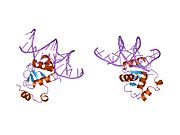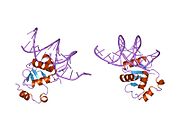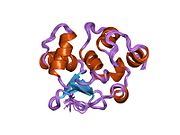ETS1
Ensembl | |||||||||
|---|---|---|---|---|---|---|---|---|---|
| UniProt | |||||||||
| RefSeq (mRNA) | |||||||||
| RefSeq (protein) |
| ||||||||
| Location (UCSC) | Chr 11: 128.46 – 128.59 Mb | Chr 9: 32.64 – 32.76 Mb | |||||||
| PubMed search | [3] | [4] | |||||||
| View/Edit Human | View/Edit Mouse |
Protein C-ets-1 is a protein that in humans is encoded by the ETS1 gene.[5] The protein encoded by this gene belongs to the ETS family of transcription factors.[6]
Function
There are 28 ETS genes in humans and 27 in mice. They bind the DNA via their winged-helix-turn-helix DNA binding motif known as the Ets domain that specifically recognizes DNA sequences that contain a GGAA/T core element. However, Ets proteins differ significantly in their preference for the sequence flanking the GGAA/T core motif. For instance, the consensus sequence for Ets1 is PuCC/a-GGAA/T-GCPy. On the other hand, many natural Ets1-responsive GGAA/T elements differ from this consensus sequence. The later suggests that several other transcription factors may facilitate Ets1 binding to unfavorable DNA sequences.
Ets1 binds to DNA as a monomer. Phosphorylation of serine residues of the C-terminal domain (in the nucleotide sequence they belong to exon VII) known as autoinhibition makes Ets1 inactive. There are several ways to activate Ets1. First, Ets1 can be dephosphorylated. Second, two Ets1 can be activated If two Ets molecules homodimerize. The homodimerization occurs if DNA binding sites are present in the correct orientation and spacing. Thus, the exact layout of binding sites within an enhancer or promoter segment to either relieve or allow autoinhibition of Ets1 to occur may strongly influence whether or not Ets1 actually binds to particular site. Third, Ets1 can be activated by Erk2 and Ras at Thr38. The truncated isoform cannot be phosphorylated by the Erk2. It is localized in the cytoplasm and acts as a dominant negative isoform. Contrary, another isoform that misses exon VII is constitutively active. Many Ras responsive genes harbor combinatorial Ets/AP1 recognition motifs through which Ets1 and AP1 synergistically activate transcription when stimulated by Ras.[8]
In adult humans, Ets1 is expressed at high levels mainly in immune tissues such as thymus, spleen, and lymph node (B cells, T cells, NK cells, and NK T cells and non-lymphoid immune cells). An enforced expression of Ets1 blocks differentiation of B- and T-cells. By contrast, knocking Ets1 down causes multiple defects in the immune system.
Knockout mice
Ets1
Clinical significance
Meta-analyses of multiple genome-wide association studies has suggested an association of SNPs in the ETS1 locus with psoriasis in European populations. This is not surprising because Ets1 is a negative regulator of Th17 cells.
Ets1 overexpression in stratified squamous epithelial cells causes pro-oncogenic changes, such as suspension of terminal differentiation, high secretion of matrix metalloproteases (Mmps), epidermal growth factor ligands, and inflammatory mediators.
Interactions
Ets1 directly interacts with various transcription factors. Their interaction results in formation of multiprotein complexes. When Ets1 interacts with other transcription factors (Runx1, Pax5, TFE3, and USF1) its final effect on transcription depends on whether C-terminal domain is phosphorylated. Acetyltransferases CBP and p300 bind to the transactivation domain. AP1, STAT5 and VDR bind to C-terminal domain.
Also, ETS1 has been shown to
Importantly, ETS1 was shown to be able to bind both nucleosome-bound and -depleted DNA, with its suppression leading to increases in nucleosomal occupancy at sites normally bound by ETS1. [7]
Interaction with DNA repair promoters and proteins
DNA repair promoters
The messenger RNA and protein levels of DNA repair protein PARP1 are controlled, in part, by the expression level of the ETS1 transcription factor which interacts with multiple ETS1 binding sites in the promoter region of PARP1.[12] The degree to which the ETS1 transcription factor can bind to its binding sites on the PARP1 promoter depends on the methylation status of the CpG islands in the ETS1 binding sites in the PARP1 promoter.[13] If these CpG islands in ETS1 binding sites of the PARP1 promoter are epigenetically hypomethylated, PARP1 is expressed at an elevated level.[13] The high constitutive levels of PARP1 in centenarians, providing more effective DNA repair, is thought to contribute to their unusual longevity. These levels of PARP1 expression are considered to be due to altered epigenetic control of transactivation of PARP1 expression.[14]
As shown by Wilson et al.,[15] increased ETS1 expression causes about 50 target genes to increase expression, including DNA repair genes MUTYH, BARD1, ERCC1 and XPA. Increased ETS1 expression causes resistance to cell killing by cisplatin, the resistance thought to be partly due to increased expression of DNA repair genes.
DNA repair protein interactions
ETS1 functions are regulated by protein – protein interactions.
As shown by Legrand et al.,[19] ETS1 protein interacts with PARP1 protein. ETS1 activates PARP1, causing poly ADP-ribosylation of PARP1 itself and of other proteins, even in the absence of nicked DNA. PARP1 (without self- poly ADP-ribosylation), in turn, is needed for activation of the transactivating activity of ETS1 on a tested promoter. Active PARP1 subsequently causes poly ADP-ribosylation of ETS1, and this appears to promote ETS1 ubiquitination and proteasomal degradation, preventing excessive activity of ETS1.
References
- ^ a b c GRCh38: Ensembl release 89: ENSG00000134954 – Ensembl, May 2017
- ^ a b c GRCm38: Ensembl release 89: ENSMUSG00000032035 – Ensembl, May 2017
- ^ "Human PubMed Reference:". National Center for Biotechnology Information, U.S. National Library of Medicine.
- ^ "Mouse PubMed Reference:". National Center for Biotechnology Information, U.S. National Library of Medicine.
- S2CID 4331584.
- S2CID 44532648.
- ^ PMID 26673693.
- PMID 9644975.
- S2CID 35966215.
- S2CID 26170389.
- S2CID 22299529.
- S2CID 43548938.
- ^ PMID 23762867.
- PMID 17518695.
- S2CID 27514847.
- PMID 11175367.
- ^ PMID 19836356.
- PMID 25083921.
- PMID 23405229.
Further reading
- Reddy ES, Rao VN (1988). "Structure, expression and alternative splicing of the human c-ets-1 proto-oncogene". Oncogene Research. 3 (3): 239–46. PMID 3060801.
- Lincoln DW, Bove K (Jan 2005). "The transcription factor Ets-1 in breast cancer". Frontiers in Bioscience. 10 (1–3): 506–11. PMID 15574387.
External links
- ETS1+protein,+human at the U.S. National Library of Medicine Medical Subject Headings (MeSH)
- Drosophila pointed - The Interactive Fly
- FactorBook ETS1
This article incorporates text from the United States National Library of Medicine, which is in the public domain.










